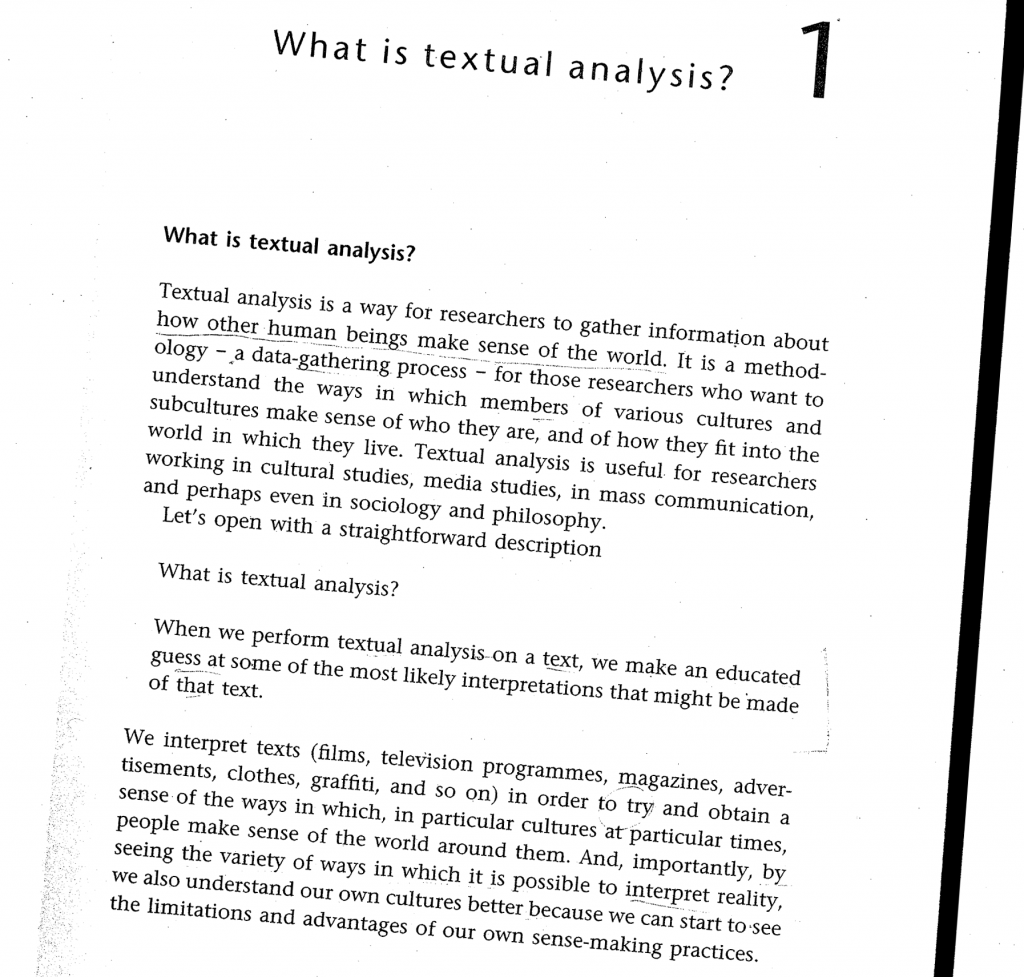I found these notes from an assignment I submitted recently and thought they might be helpful for anyone heading in to a textual analysis exam. This summary is useful for reviewing advertisements prior to publshing for those who work in the advertising industry and agency environments.

SIGNS –> CONNOTATIONS –> CODES –> DENOTATIONS –> MYTHS = Textual Analysis – our job is the why.
These notes were used prior to a textual analysis exam. It can be handy to revert to this quick list of reminders!
- Why would the ad have been crafted this way? Ie this is why McDonalds used these ‘signs’ to market an ad to a tween audience for a burger product.
- Use simple sentences. The main signifier is THIS and the example is THIS.
- Cover well the elements that make our case. Ie, these women are the most important part of the message because… cover ad 1, cover ad 2 then compare both. Explain what you are doing first. “I will look at layout, then I‘ll look at the people/logo.
- 1) based on part, not all. 2) term/example, term/example. 3) signpost what you are doing.
- Take 5 minutes to plan.
- If just choosing 1 image to analyse, explain well the reason why.
- Intended audience? Yes. No.
Tips for textual analysis exams:
- Make a case. Rather than trying to answer three or so questions and use all the key terms in an unstructured way, focus your analysis on a case about *why* these ads are constructed the way they are, using the suggested questions and key terms to help make that case. Find one or two things to focus on rather than trying to write about everything in the ads.
- Use examples and less is more. Whenever you use a key term, follow it with an example. Don’t use a key term if you don’t understand it–better to write well about a few things than write poorly about many things.
- Signposting. Have a plan for ordering the parts of your case’s evidence and tell the reader what you are doing. “the images in the two ads…”, and later, “the text in the ads…”, and later, “Now we turn to the layout of the ads…” etc. OR “people’s clothing in the two ads shows…”, “the physical settings of the ads show…”
Key Words, Terms & Braindump
Positive negative imagery. Dimensions of difference. Stereotyping is a representational practice, works by essentialising reductionism, naturalization, binary, oppositions, caught up in power play (hegemony) power/knowledge conscious effects are fantasy, fetishism, disavowal. New battle is politics of representation. Key terms in stereotyping – normal, deviant, pathological, acceptable, unacceptable, belongs, other, insider, outsider, us, them, binding, imagined, community, purity, thrown out, binary opposition (there are 2 sides to stereotypes … therefore always a violent struggle of one over the other, natural, inevitable. Power, dominant group power and representation relationship. Fantasy + projection = effects (splitting & ambivalence, desires, repressions, investments and projection … fetishism)
Definitions for Textual Analysis
- Sign – anything which produces meaning, objects
- Signifier – the sign which is doing the signification
- Signified – the meaning signified by the sign or signifier
- Code – sets of rules for interpreting (by context) meaning, subsets, rules.
- Connotation – set of possible signified from a sign
- Denotation – most stable and objectionably verifiable of its connotations
- Metaphor – the metaphor is an implicit or explicit comparison (transference)
- Metonymy – use part to represent a whole, association of terms
- Paradigm – set of interchangeable signs. Elements + rule = syntagm.
- Syntagm – ordered array of signs combined according to certain rules.
- Addresser – position construction as source (ie advertiser)
- Addressee – position intended as destination or target audience
- Myth – coding in which dominant terms stands for all terms metonymically
- Genre – type of text.
- Effect – radical simplification of relationships in system.
- Ethnocentrism – application of the norms of one’s own culture onto that of others. (brown 1965 p183)
- Transference – when metaphor comparison transfers meaning to signs.
- Anchorage – when a caption on a photo creates stabilizations
- Referent – cat is a sign, refers to the animal we know as cat. Referent is different in languages)
- Hegemony – form of power based on leadership across range of services, appearing normal.
- Representation – scholarship, exhibition, literature, painting etc.
- Fragmentation – body broken up into a selection of parts.
- Fetishism – substitute for an absent phallis, displacement. Licenses an unregulated voyeurism.
- Contextual – What context?
How do signs work?
- A signs metalingual function suggests codes by which texts may be understood
- A signs formal functions involve structure and format which text takes
- A signs expressive function is construction of an addresser
- A signs conative function is its construction of an addressee
- The relationship between these are the phatic functions.
References
> Textual Analysis – A Beginner’s Guide
